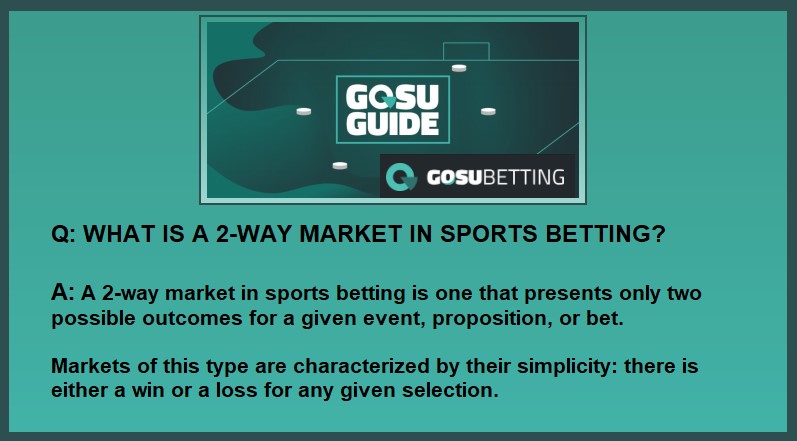Navigating the landscape of sports betting can be overwhelming, particularly for beginners. The sheer variety of bets and betting markets can be confusing, and understanding each different type of bet is fundamental to a successful and enjoyable wagering experience.
A common term you will encounter is the “2-way market,” but what exactly does this mean?
This article will provide a clear and comprehensive overview of what a 2-way market is, how it works, and how it differs from other betting options. We’ll delve into some of the most common 2-way markets and provide you with a full and thorough understanding of these simple yet powerful betting concepts.
Understanding the 2-Way Market

At its core, a 2-way market in sports betting is a market that presents only two possible outcomes for a given event or proposition.
These markets, sometimes referred to as a binary market or a two-option bet, are characterized by their simplicity: there is either a win or a loss for any given selection.
This contrasts with other markets that may have three possible results, and they provide a dichotomous outcome for the bettor, where only one of two possible scenarios will play out.
The dual-option proposition is designed for simplicity. The bettor needs only to choose one of the exclusive alternatives, making it ideal for both novice and experienced gamblers.
Key Characteristics of a 2-Way Market
- Two Outcomes: Only two possible results exist.
- Binary Choice: Bettors choose between two mutually exclusive options.
- Direct Win/Loss: The bet typically resolves as either a win or a loss.
- Simplicity: These markets are often straightforward and easy to understand.
Common 2-Way Betting Markets
Several types of bets commonly fall under the umbrella of the 2-way market, with some of the most common including:
Moneyline Betting
Often seen in sports like baseball, hockey, and tennis, a moneyline bet involves selecting which team or individual you believe will win a match outright.
In a traditional moneyline bet a draw is removed as a possibility, presenting only two options: a win for either participant.
This single-outcome wager presents a direct result selection and allows the bettor to pick a head-to-head outcome. Moneyline bets are considered the pure win/loss outcome of any sporting event.
Over/Under (Totals)
While many over/under totals bets allow for three or more outcomes, a modified version of the total score bet can result in a 2-way market.
In this scenario, the sportsbooks set the point total or goals total at a level that, when combined with the final score of a match, is guaranteed to result in a win for either the over or under selection.
These binary totals present a two-option total and require predicting where the total will fall relative to a set line. This type of wager offers an exclusive range selection using a dichotomous totals outcome.
A bettor chooses either over or under and the outcome will always fall into one of those two categories. This boundary-based totals outcome creates a two-sided aggregate wager that is ultimately a binary-total prediction.
Handicap Betting (2-Way)
In a typical handicap bet there are often three possible outcomes. However, a 2-way handicap bet is designed to remove the possibility of a push result, often using a half-point spread (e.g., +/- 0.5) to remove any draw or tie situation.
By using a +/- 0.5 point or goal handicap the bet now has a two-option handicap and becomes a binary handicap. This bet now features an adjusted outcome selection and the two-outcome handicap scenario ensures that there is now a direct margin-based wager. This results in a balanced points outcome where the bettor wins or loses depending on whether or not they have selected the appropriate outcome.
Draw No Bet
A draw no bet provides another version of a 2-way market. This type of wager removes the tie as an option, and if the result is a draw the stake is returned to the bettor. It offers a mitigated-risk outcome by eliminating the potential loss if there is a tie. Therefore, this bet presents a return of capital scenario.
This type of selection focuses on a win-focused outcome and a draw contingency wager where a draw essentially makes the bet void.
What is Not a 2-Way Market?
Understanding what a 2-way market is not can be just as important. Here are some examples of betting markets that are not 2-way:
- Double Chance: While a double chance bet covers two out of three possible outcomes (e.g., a win or draw for a team), it’s fundamentally a multi-outcome wager. By its nature, it provides a joint selection proposition and overlapping result opportunities, and therefore it is not a 2-way market. While it does cover two of three outcomes, it is not a 2-way wager, as there is still a third outcome. It can be seen as an enhanced chance bet, but it is still not a dual-selection outcome.
- Push Results: In many sports betting markets, especially those that feature whole-number point spreads (e.g., +/- 2 points), you can encounter a push result. In this scenario, if a team wins (or loses) by exactly the handicap margin, the bet becomes a non-decisive outcome, and the stake is typically refunded. This is because it is a returned stake condition, and the result is a neutral result scenario that is also a no-outcome result, which makes it not a 2-way market. It can be best thought of as a wager-refund event.
Key Concepts to Consider
- Binary Outcome: The idea of a binary outcome is fundamental to a 2-way market. A two-option result exists where only one of the dual possibilities can occur. The bet will ultimately result in a dichotomous result where only one of two potential outcomes is true. It is therefore a two-state outcome, that requires a bettor to choose between two distinct choices. This is a simple alternative choice model, that offers a dichotomous win/loss.
- Excluding Draws: Many 2-way markets create non-tie outcome markets by eliminating the tie as a possible result and use a draw elimination feature. This simplified win/loss market makes the 2-way market so easy to understand, as it is a no draw-based outcome. This is achieved by excluding draws and removing the possibility of void results.
Why Choose 2-Way Markets For Your Betting?
There are a few strong benefits to betting in 2-ways:
- Simplicity: 2-way markets are often easier to understand and analyze than markets with multiple outcomes.
- Clarity: The binary nature of the outcome provides a clear “win or lose” scenario.
- Accessibility: These are ideal for beginners due to their straightforward approach.
- Strategic Options: Even within the simplicity of 2-way markets, there are opportunities to apply specific strategies.
Summary
In summary, a 2-way market is characterized by its binary nature, presenting only two possible outcomes for a wager.
Understanding this concept is key to navigating a broad array of sports betting options, and is a necessary foundation for more complex bets.
From the simplicity of moneyline bets to more complex applications in over/under and handicap markets, 2-way markets offer a streamlined and accessible way to enjoy betting on sports. By understanding the nuances of what defines a 2-way market, bettors of all experience levels will be able to make smarter and more informed wagering choices
Ready to try out some straightforward moneyline or simple win bets? These GOSUBetting recommended crypto bookmakers are all good for bettors seeking 2-way betting opportunities:
Top Bitcoin Betting Sites For 2-Way Betting
BC.Game
Welcome Bonus: Four-part deal up to $1,600
18+ – Gamble responsibly – GambleAware.org – T&C’s apply




